Air Freight Mission Texas
Move your deliveries faster with air charter, air freight, and hand carry urgent shipping solutions in Mission, Texas. Situated on the U.S.-Mexico border within Hidalgo County, Mission, Texas is well-regarded for its significant population growth and diverse economic activity. Discover what makes Mission the right location for your next shipping operations.
AIR FREIGHT SERVICES MISSION
Ultra-Critical Delivery Shipments in Mission
The city of Mission, Texas, supports a diversified industry base, including health services, retail trade, education, food and beverage production, manufacturing, and transportation. This unique blend fosters a highly competitive business environment, strengthened by comprehensive multimodal transportation networks.
The city's direct access to key markets, coupled with its role in cross-border trade and manufacturing, inherently creates complex and time-sensitive shipping requirements. That's where AirFreight's time-critical shipping services come in.
AirFreight.com offers the precise shipping solutions businesses in this region need to thrive. We offer urgent hand carry, rapid air freight, and dedicated air charter services, all meticulously tailored to meet Mission's unique demands. We'll work with you one-on-one to determine the unique needs of your shipping needs, based on your industry and geographic region.
Our extensive network of carriers provides access to a diverse fleet of aircraft, ensuring we can perfectly match the right aircraft and service to your specific cargo needs, regardless of size, weight, or urgency. Coupled with our single point of contact for dedicated support, we guarantee certainty and peace of mind for every shipment.
Request a Quote Now
Add your shipment details below, and one of our professional expeditors will contact you within minutes. For immediate assistance on an urgent quote, call (210) 598-5300 with these details handy.
Key geographic position that streamlines cross-border commerce and global operations
Pro-business environment featuring significant tax advantages and a supportive ecosystem for enterprise growth
Vast and highly skilled talent pool, fueled by a diverse and educated workforce
Strong foundation for growth, supported by advanced utilities and a comprehensive network of transportation infrastructure
Accelerated Shipping Support Throughout Mission
AirFreight.com provides fast and reliable expedited shipping solutions for the Mission, Texas area. We prioritize precision and speed to meet the unique demands of the dynamic border economy, ensuring your most critical shipments are delivered seamlessly and on time.
Our services include Next Flight Out (NFO) and time-definite express options directly from Mission, or via nearby McAllen International Airport (MFE). This ensures your urgent freight is prioritized on the earliest available flights, leveraging our extensive network for the fastest possible delivery, crucial for industries with demanding schedules.
We also provide seamless same-day and next-day delivery throughout Mission and to surrounding areas in the Rio Grande Valley. Whether it's vital documents for cross-border operations, essential components for manufacturing, or high-value retail inventory, our rapid ground solutions keep your local supply chains uninterrupted.
Every shipment benefits from real-time tracking and 24/7 support for Mission's businesses. You'll have continuous, up-to-the-minute visibility into your cargo's journey, alongside round-the-clock access to our dedicated specialists for immediate assistance. Our comprehensive door-to-door and airport-to-airport service manages the entire shipping process, from pickup at your Mission facility to direct final delivery or efficient transfers at major regional airports.
Collaborate with AirFreight.com to find the perfect urgent shipping and delivery services for your needs.
KEY BENEFITS
Protect every critical shipment with meticulous attention to detail.
Your most valuable or sensitive cargo, from delicate medical equipment to high-value electronics, receives our utmost care. Our processes are specifically designed for precision, minimizing risk from pickup to final delivery. We focus on every detail to ensure your valuable shipments arrive in perfect condition, providing complete peace of mind.
Meet the Team
Leverage the deep knowledge and experience of our logistics professionals.
Our team of industry professionals brings decades of experience in managing complex shipping challenges. They possess key insights into specific industries, business lines, and geographical regions, allowing them to anticipate needs and select optimal solutions. This expert oversight guarantees efficiency and foresight for your cargo, ensuring it's in the most capable hands.
Learn More About Us
Access responsive, 24/7 assistance tailored precisely to your evolving needs.
Urgent questions or concerns after shipment? Our team provides 24/7/365 support to answer questions and offer guidance. Your single point of contact provides real-time updates, proactive solutions, and immediate problem resolution so you can rest assured your delivery will arrive on time and in pristine condition to its final destination.
EXPLORE OUR COVERAGEUtilize a robust network of modern aircraft precisely matched to your cargo's needs.
Our network of carriers allows us to match you with the best aircraft for your shipment, every time. This network includes everything from agile jets for small, urgent packages to larger cargo planes capable of transporting oversized or heavy freight. We select the ideal aircraft to perfectly suit your cargo's unique specifications, optimizing speed, capacity, and security for every critical delivery.
VIEW ALL AIRCRAFTMission By the Numbers

#1
Best Small City for Growth in the Nation
Mission was recognized as the leading small city in the U.S. for its overall growth, showcasing its dynamic expansion in population, economy, and business activity.

400+
Industrial Facilities
Mission's proximity to the U.S.-Mexico border provides direct access to over 400 industrial facilities (maquiladoras) across the border, positioning it as a vital nearshoring hub for manufacturing and international trade.

4th
Fastest-Growing Area in the U.S.
Mission is a central player within the rapidly expanding Rio Grande Valley, one of the nation's fastest-growing regions, signifying immense market potential and a continually expanding workforce.
Dynamic Air Freight Shipping Solutions in Mission, Texas
Mission's health services, anchored by Mission Regional Medical Center, providing vital medical care to the region. Manufacturing facilities, like Frito-Lay and Duro Bag Manufacturing, alongside food and beverage production and specialized operations providers, such as Mission Shippers, also make up a large portion of the local economy. These industries, many dealing with high-value or time-sensitive goods, inherently create a constant demand for expedited and reliable shipping.
Beyond its core industries, Mission is supported by a continually deepening talent pool, cultivated by area colleges and universities that collectively enroll over 60,000 students. This ensures a skilled workforce ready to meet the demands of growing sectors. The city's comprehensive multimodal transportation networks, including proximity to international bridges and major highways, intensify the need for efficient deliveries that can keep pace with its rapid growth and extensive cross-border trade.
AirFreight.com is your essential partner for shipping strategies in Mission, Texas. We understand that Mission's diverse industries require unique, tailored solutions that go beyond standard shipping. We work collaboratively to develop customized air charter, air freight, and hand-carry options meticulously engineered to safeguard against mishandling or damage of your most critical shipments, ensuring secure, reliable, and on-time delivery every time.
Top Industries in Mission

Retail
Mission serves as a significant retail hub within the Rio Grande Valley, featuring major stores like Walmart Supercenter and Target, alongside local shopping centers and numerous small businesses. The high volume of consumer goods, seasonal inventory, and e-commerce fulfillment necessitates swift air freight for rapid replenishment and efficient distribution to meet consumer demand.

Manufacturing
Mission's manufacturing sector is robust, with facilities like Modine (thermal solutions) and Duro Bag Manufacturing. Strong ties to industrial facilities (maquiladoras) across the Mexican border mean a constant flow of components and finished goods. This relies on rapid air freight for just-in-time parts, urgent supply chain adjustments, and efficient product distribution.

Technology
While not a primary tech manufacturing hub, Mission has a presence in supporting technology and engineering services, with companies like KCI Technologies (consulting engineers) and Custom Information Services (IT support). These businesses often require expedited transport for specialized equipment or sensitive electronic components.

Hospitality
Mission's hospitality industry caters to a steady stream of business travelers, cross-border visitors, and tourists exploring the Rio Grande Valley. Hotels such as Hampton Inn & Suites Mission and SureStay by Best Western Mission serve this demand. Expedited air freight ensures timely delivery of specialty food items, luxury amenities, and event supplies, crucial for maintaining high service standards during peak seasons and local events.
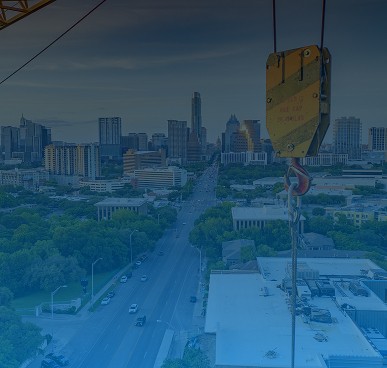
Construction
Mission is experiencing continuous development, including new residential communities and commercial projects. Construction companies frequently need urgent delivery of specialized tools, replacement parts for heavy machinery, and high-value building materials. Air freight is vital for keeping these projects on schedule and preventing delays.
RENEWABLES & ENVIRONMENT
Mission is active in the broader Rio Grande Valley's push for sustainable development. Companies like Civil & Environmental Consultants, Inc. (CEC) and Terracon offer specialized services in environmental engineering. Additionally, the region is home to efforts in solar energy, with companies like Mission Solar Energy contributing to renewable power.
Top Airports in Mission
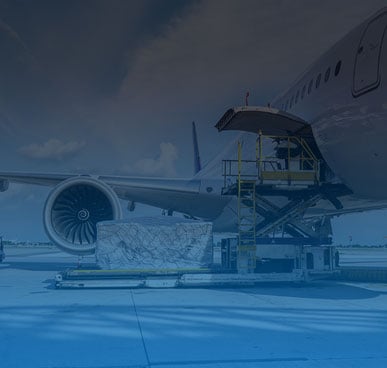
MFE
McAllen International Airport
Located directly in McAllen, McAllen International Airport (MFE) is a vital commercial hub for the city and the wider Rio Grande Valley. It offers direct domestic flights to major U.S. hubs and international connections to Mexico. MFE is well-equipped for cargo operations, with dedicated facilities and U.S. Customs, essential for the rapid movement of goods tied to the region's strong manufacturing and trade sectors.
Your Single Point of Contact for Seamless Deliveries
Ready to experience truly seamless urgent shipping in Mission? With AirFreight.com, you'll work one-on-one with a dedicated specialist. This individual is your go-to shipping expert, providing responsive, ongoing support around the clock, 24/7/365.
Your specialist deeply understands your industry, the unique dynamics of the Mission region, and your specific business needs. This tailored partnership streamlines the entire process, fostering unparalleled peace of mind for your core operations.

Hi, I'm Steve
Reach out today and let's solve your urgent shipping needs. I or a member of the team will be with you from start to finish.
Aircraft Details & Interiors for Every Type of Cargo
Boeing 747-400F
Built for efficient delivery of huge loads to any corner of the globe. The wide-body design, with opening nose, large side door and cargo handling system, simplifies loading and unloading.

Top Down Cutaway
Main Deck (Top)
Lower Deck (Bottom)
Max Payload
Cubic ft: 24,115
Weight: 274,000
Side Cargo Doors
Main Deck Aft
Width: 134 in
Height: 120 in
Lower Deck Fore
& Aft
Width: 110 in
Height: 66 in
Nose Cargo Door
Width: 140 in
Height: 98 in

Range & Routes
The 747-400F has a non-stop range of approximately 5,200 miles fully loaded, making it ideal for routes throughout the 50 states and those connecting major global markets worldwide. Its long-range capabilities mean fewer stopovers and reduced transit time, lowering the risk of cargo handling delays.
A Boeing 747-400F typically flies routes connecting many major cities in the United States to hubs in Europe and Asia, including but not limited to Amsterdam, Frankfurt, Tokyo, Seoul, Shanghai, Hong Kong, Taipei, and Singapore.
Airport Requirements
The 747-400F is a large aircraft and requires airports equipped to handle its size and weight. Airports need sufficiently wide and strong runways to support the 747-400F’s maximum takeoff weight. Runway pavements must be rated to support nearly 400 tons, including the added weight during takeoff and landing maneuvers.
Taxiway Width: The aircraft’s length of 232 feet and wingspan of 211 feet mean it needs wide taxiways with large available areas to accommodate its turning radius.
Many major cargo hubs are very familiar with and already accommodate the 747-400F, although smaller regional airports may face some limitations.
Parking Apron Space: The 747-400F requires spacious parking aprons that allow for loading, unloading, and servicing. The need for access to its nose door also means parking space should not be too close to other obstacles.
Runway Requirements
Takeoff Runway Length: For a fully loaded 747-400F, a runway length of approximately 10,500 feet is generally required to safely reach takeoff speed. This requirement can vary based on altitude, temperature, and wind conditions. High-altitude airports with elevations over 8,000 feet may require longer runways due to lower air density.
Landing Runway Length: The 747-400F requires a minimum runway length of 7,500 feet, depending on its landing weight and weather conditions. Wet or dry runway conditions may increase the minimum landing distance required for safe operation.
Crew
The 747-400F is flown with a pilot and co-pilot. Additional cargo support personnel may be assigned to the flight by AirFreight.com to monitor the cargo and coordinate seamless end-to-end delivery.
KEY AIRCRAFT SPECIFICATIONS
Length
232 feet
Wingspan
211 feet
Maximum Takeoff Weight
875,000 pounds
Maximum Payload
Approximately 274,000 pounds
Range
5,200 miles with a full payload
Cargo Volume
Approximately 24,000 cubic feet
Cruise Speed
570 miles per hour or Mach 0.85
Engines
Typically equipped with four high-thrust engines like the Pratt & Whitney PW4000, General Electric CF6, or Rolls-Royce RB211
Pilatus PC-12
A small, single-engined aircraft with a generously sized aft cargo door. Intended for short-to-medium-range travel, the PC-12 can operate out of small airfields and is known for safety and reliability.

Top Down Cutaway
Main Deck
Side Cargo Door
Width: 53 in
Height: 52 in
Max Payload
Cubic Ft: 400
Weight: 2,400

Range & Routes
The Pilatus PC-12 flies a variety of domestic routes within the contiguous US. It has a non-stop range of approximately 1,700 miles at maximum payload, making it ideal for established routes or servicing remote locations throughout the US, Canada, and Mexico.
Airport Requirements
The Pilatus PC-12 is considered to be a light, turboprop utility aircraft and can take off and land at any established airport or remote areas with undeveloped infrastructure or unpaved, gravel, or grass runways.
Taxiway Width: The aircraft’s length of 49 feet and wingspan of 54 feet means it can operate on narrow taxiways.
Parking Apron Space: The Pilatus PC-12 does not require a spacious parking apron for loading, unloading, and servicing.
Ground Handling: Specialized equipment is generally not needed to load and unload cargo in this aircraft. There is enough area behind the left wing to manually load cargo, install a ramp to assist with loading wheeled cargo, or maneuver a forklift to load palleted cargo directly into the aircraft.
Fueling: Refueling may be carried out using fuel containers, fuel pumps, or fuel trucks. Fuel capacity is ultimately dependent on the weight of the payload carried by the aircraft and the range of travel required but can be up to 400 gallons.
Power and Air Support: The Pilatus PC-12 does not generally require external electrical power or support. In cases where the aircraft requires external power while the engine is off, a 28-volt ground power unit can be connected to the aircraft’s auxiliary power port.
Runway Requirements
Takeoff Runway Length: For a fully loaded Pilatus PC-12, a minimum runway length of approximately 2,500 feet is required to safely reach takeoff speed from a paved runway. This requirement will vary based on altitude, temperature, wind conditions, and runway conditions. High-altitude airports with elevations over 8,000 feet may require longer runways due to lower air density.
Landing Runway Length: The Pilatus PC-12 requires a normal minimum runway length of 2,200 feet at maximum payload. Wet, icy, unpaved, gravel, or grass runways may increase the minimum landing distance required for safe operation.
Crew
The Pilatus PC-12 is certified to fly with a single pilot, but two pilots can be used depending on the operating parameters and needs of the trip. Additional cargo support personnel may be assigned to the flight by the carrier to monitor the cargo and coordinate seamless end-to-end delivery.
KEY AIRCRAFT SPECIFICATIONS
Length
49 feet
Wingspan
54 feet
Maximum Takeoff Weight
10,400 pounds
Maximum Payload
Approximately 2,400 pounds
Range
Dependent on the model; the minimum range is approximately 1,700 miles with a full payload including crew, fuel, and cargo
Cargo Volume
Approximately 400 cubic feet
Cruise Speed
330 miles per hour
Engines
Typically equipped with one Pratt & Whitney Canada PT6A-67P turboprop engine
Antonov An-124
A massive aircraft designed from the outset for cargo. Features an opening nose and a large rear door for easy loading and unloading. Handles the largest loads of any aircraft.

Top Down Cutaway
Main Deck
Cargo Cross Section
Width: 251 in
Height: 173 in
Max Payload
Cubic ft: 36,085
Weight: 264,554
Nose Cargo Door
Width: 251 in
Height: 173 in

Range & Routes
The An-124 is a highly specialized aircraft and flies a variety of international routes based on need and the type of cargo being airlifted. It has a non-stop range of approximately 2,300 miles fully loaded, making it ideal for routes throughout the US, Canada, and Mexico, and routes connecting major global markets worldwide.
Airport Requirements
The An-124 is a very large aircraft and requires airports equipped to handle its size and weight. Airports need sufficiently wide and strong runways to support its maximum takeoff weight. Runway pavements must be rated to support nearly 400 tons, including the added weight during takeoff and landing maneuvers.
Taxiway Width: The aircraft’s length of 232 feet and wingspan of 213 feet mean it needs wide taxiways with large available areas to accommodate its turning radius.
Many major cargo hubs in the USA, such as, but not limited to, JFK, Miami, Philadelphia, Dallas/Fort Worth, LAX, Moffett Field, are very familiar with and already accommodate the An-124. Smaller regional airports may face some limitations.
Parking Apron Space: The An-124 requires spacious parking aprons that allow for loading, unloading, and servicing. The need for access to its nose and rear cargo doors also means parking space should not be too close to other obstacles.
Ground Handling: Specialized equipment may be needed to load and unload cargo, including cranes, forklifts, and custom loaders.
Fueling: Refueling may be carried out using high pressure aviation refueling systems or a pantograph fuel hydrant. Fuel capacity is ultimately dependent on the weight of the payload carried by the An-124 but may be approximately 65,000 gallons.
Power and Air Support: The An-124 contains two internal auxiliary power units. Additional ground power units may be needed to back up the internal crane systems.
Runway Requirements
Takeoff Runway Length: For a fully loaded An-124, a minimum runway length of approximately 9,800 feet is required to safely reach takeoff speed. This requirement can vary based on altitude, temperature, and wind conditions. High-altitude airports with elevations over 8,000 feet may require longer runways due to lower air density.
Landing Runway Length: The An-124 requires a normal minimum runway length of 7,800 feet at maximum payload, but a minimum landing distance of 3,000 feet might be achieved if absolutely necessary. 3,000 feet is considered extremely short for an aircraft of this size and weight and is made possible by its powerful thrust-reversing engines. Wet, icy, or unpaved runways may increase the minimum landing distance required for safe operation.
Crew
The An-124 is flown with a crew of eight: pilot and co-pilot, navigator, flight engineer, electrical flight engineer, radio operator, and two load masters. Additional cargo support personnel may be assigned to the flight by AirFreight.com to monitor the cargo and coordinate seamless end-to-end delivery.
KEY AIRCRAFT SPECIFICATIONS
Length
226 feet
Wingspan
240 feet
Maximum Takeoff Weight
886,000 pounds
Maximum Payload
Approximately 264,000 pounds
Range
2,300 miles with a full payload
Cargo Volume
Approximately 36,000 cubic feet
Cruise Speed
535 miles per hour or Mach 0.69
Engines
Typically equipped with four high-thrust Progress D-18T high-bypass turbofan engines
Boeing 777-200F
With cargo capacity approaching that of the 747-400F, this large aircraft was engineered for exceptionally long range. It’s a good choice for inter-continental delivery of large, heavy, and bulky freight.

Top Down Cutaway
Main Deck (Top)
Lower Deck (Bottom)
Max Payload
Cubic ft: 23,060
Weight: 222,075
Side Cargo Doors
Main Deck Aft
Width: 142 in
Height: 120 in
Lower Deck Fore
& Aft
Width: 106 in
Height: 67 in

Range & Routes
The 777-200F addresses a wide range of demands, including long-haul intercontinental routes to regional operations, making it an attractive choice in terms of flexibility and cost efficiency. It has a non-stop range of approximately 5,720 miles with a full payload, which allows for domestic or long-haul flights without the need for refueling, meaning reduced transit time and lower risk of cargo handling delays.
Airport Requirements
The 777-200F can operate efficiently in most modern airports and is not hindered by possible limitations that may be associated with larger aircraft in terms of ground handling and gate access.
Taxiway Width: The aircraft’s length of 209 feet and wingspan of 213 feet mean it needs wide taxiways with large available areas to accommodate its turning radius. Many major cargo hubs, domestic and worldwide, are very familiar with and already accommodate the 777-200F. Smaller regional airports may face some limitations.
Parking Apron Space: Space around the aircraft is needed for ground service equipment, such as cargo loaders, tugs, and refuelers.
Ground Handling: Standard ground handling equipment is needed to load and unload cargo such as roller equipped high-lift dollies for the upper main deck and belt or cargo loaders for the lower deck.
Fueling: Refueling may be carried out using high pressure aviation refueling systems from fuel trucks or a fuel hydrant. Capacity for the 777-200F can be up to 47,000 gallons stored in its wings and center tank but is dependent on payload and the point-to-point distance the aircraft is required to travel.
Runway Requirements
Takeoff Runway Length: At maximum payload, the 777-200F typically requires 10,000 to 12,000 feet of runway for takeoff. With lighter payloads, the aircraft may be able to take off on shorter runways. This requirement can vary based on altitude, temperature, and wind conditions. High-altitude airports with elevations over 8,000 feet may require longer runways due to lower air density.
Landing Runway Length: At maximum payload, the 777-200F typically requires a runway length between 6,000 and 8,000 feet. Wet, icy, or unpaved runways may increase the minimum landing distance required for safe operation.
Crew
The 777-200F is flown with a pilot and co-pilot. Additional cargo support personnel may be assigned to the flight by AirFreight.com to monitor the cargo and coordinate seamless end-to-end delivery.
KEY AIRCRAFT SPECIFICATIONS
Length
209 feet
Wingspan
213 feet
Maximum Takeoff Weight
765,000 pounds
Maximum Payload
Approximately 222,000 pounds
Range
5,720 miles with a full payload
Cargo Volume
Approximately 23,000 cubic feet
Cruise Speed
560 miles per hour or Mach 0.84
Engines
Typically equipped with two powerful General Electric GE90, Pratt & Whitney PW4000, or Rolls-Royce Trent 800 engines
McDonnell Douglas DC-10F
Large, long-range freighter employing an uncommon three-engine design. It’s capable of holding 23 pallets on the upper cargo deck. Big upper and lower doors support rapid loading and unloading.

Top Down Cutaway
Main Deck (Top)
Lower Deck (Bottom)
Max Payload
Cubic ft: 18,350
Weight: 101,805
Side Cargo Doors
Main Deck
Width: 140 in
Height: 100 in
Lower Deck Fore
Width: 66 in
Height: 104 in

Range & Routes
The McDonnell Douglas DC-10F has a non-stop range of approximately 4,200 miles at maximum payload, making it ideal for domestic routes and remote locations throughout the US, Canada, and Mexico.
Airport Requirements
The McDonnell Douglas DC-10F is a wide-body jet designed to take off and land from major international airports and active military bases, or deactivated military bases converted for civilian and commercial use.
Taxiway Width: The aircraft’s length of 182 feet and wingspan of 155 feet requires a taxiway designed for wide-body jets.
Parking Apron Space: A large parking apron is required to accommodate its length and wingspan while allowing enough room for service vehicles and equipment to maneuver.
Ground Handling: The aircraft requires a cargo loader to lift cargo to the main deck. Belt or cargo loaders may be used to transfer cargo on the lower deck.
Fueling: Fueling may be carried using large capacity fuel trucks or fueling systems capable of transferring large quantities of fuel. Fuel capacity is dependent on the weight of the payload carried by the aircraft and the range of travel required, but can be up to 24,000 gallons.
Power and Air Support: The aircraft is equipped with an internal auxiliary power unit to provide electrical and pneumatic power when the engines are not running. The aircraft may also be connected to a ground power unit to power electrical and pneumatic systems.
Runway Requirements
Takeoff Runway Length: The minimum runway length for a DC-10 at maximum payload is between 10,000 and 12,000 feet. This requirement will vary based on altitude, temperature, wind conditions, and runway conditions. High-altitude airports with elevations over 8,000 feet may require longer runways due to lower air density.
Landing Runway Length: The DC-10 at maximum payload requires a minimum runway length of between 6,000 and 7,000 feet. Wet, icy, unpaved, gravel, or grass runways may increase the minimum landing distance required for safe operation.
Crew
The McDonnell Douglas DC-10F is operated by a crew of three, two pilots and one flight engineer. Additional cargo support personnel may be assigned to the flight by the carrier to monitor the cargo and coordinate seamless end-to-end delivery.
KEY AIRCRAFT SPECIFICATIONS
Length
182 feet
Wingspan
155 feet
Maximum Takeoff Weight
555,000 pounds
Maximum Payload
Approximately 101,805 pounds
Range
Approximately 4,200 miles with a full payload including crew, fuel, and cargo
Cargo Volume
Approximately 18,350 cubic feet
Cruise Speed
585 miles per hour
Engines
Typically equipped with three General Electric CF6-50 turbofan engines
Airbus A300-600F
A large, wide-bodied aircraft designed to accommodate up to 28 pallets over two decks. Large primary and lower deck doors facilitate easy loading and unloading. Intended for medium-range flights.

Top Down Cutaway
Main Deck (Top)
Lower Deck (Bottom)
Max Payload
Cubic ft: 13,800
Weight: 103,600
Side Cargo Doors
Main Deck
Width: 141 in
Height: 101 in
Lower Deck Fore
Width: 106 in
Height: 66 in

Range & Routes
The A300-600F has a non-stop range of approximately 4,700 miles at maximum payload, making it ideal for domestic routes throughout the US, Canada, and Mexico.
Airport Requirements
The A300-600F is a wide-body jet designed to takeoff and land at well-equipped regional and major international airports that meet the requirements for handling wide-body aircraft.
Taxiway Width: The aircraft’s length of 177 feet and wingspan of 147 feet requires a taxiway designed for wide-body jets.
Parking Apron Space: A large parking apron is required to accommodate its length and wingspan while allowing enough room for service vehicles and equipment to maneuver.
Ground Handling: The aircraft requires a cargo loader to lift cargo to the main deck. Belt or cargo loaders may be used to transfer cargo on the lower deck.
Fueling: Fueling may be carried using large capacity fuel trucks or fueling systems capable of transferring large quantities of fuel. Fuel capacity is dependent on the weight of the payload carried by the aircraft and the range of travel required, but can be up to 25,500 gallons.
Power and Air Support: The aircraft is equipped with an internal auxiliary power unit to provide electrical and pneumatic power when the engines are not running. The aircraft may also be connected to a ground power unit to power electrical and pneumatic systems.
Runway Requirements
Takeoff Runway Length: The minimum runway length for an A300-600F at maximum payload is approximately 7,500 feet. This requirement will vary based on altitude, temperature, wind conditions and runway conditions. High-altitude airports with elevations over 8,000 feet may require longer runways due to lower air density.
Landing Runway Length: At maximum payload, the A300-600F requires a minimum runway length of 5,100 feet. Wet, icy, unpaved, gravel, or grass runways may increase the minimum landing distance required for safe operation.
Crew
The A300-600F is operated by two pilots. Additional cargo support personnel may be assigned to the flight by the carrier to monitor the cargo and coordinate seamless end-to-end delivery.
KEY AIRCRAFT SPECIFICATIONS
Length
177 feet
Wingspan
147 feet
Maximum Takeoff Weight
375,900 pounds
Maximum Payload
Approximately 103,600 pounds
Range
Approximately 4,700 miles with a full payload including crew, fuel, and cargo
Cargo Volume
Approximately 13,800 cubic feet
Cruise Speed
520 miles per hour
Engines
Typically equipped with two General Electric CF6-80C2 or Pratt & Whitney PW4000 turbofan engines
Boeing 767-200F
A medium- to long-range freighter known for being highly fuel-efficient in operation. Large side doors on the upper and lower decks and an integrated cargo handling system simplify loading and unloading.

Top Down Cutaway
Main Deck (Top)
Lower Deck (Bottom)
Max Payload
Cubic ft: 12,950
Weight: 92,500
Side Cargo Doors
Main Deck
Width: 133 in
Height: 96 in
Lower Deck Fore
Width: 70 in
Height: 68 in

Range & Routes
The 767-200F has a non-stop range of approximately 4,500 miles at maximum payload, making it ideal for domestic routes throughout the US, Canada, and Mexico.
Airport Requirements
The 767-200F is a wide-body jet designed to take off and land at well-equipped regional and major international airports that meet the requirements for handling wide-body aircraft.
Taxiway Width: The aircraft’s length of 159 feet and wingspan of 156 feet requires a taxiway designed for wide-body jets.
Parking Apron Space: A large parking apron is required to accommodate its length and wingspan while allowing enough room for service vehicles and equipment to maneuver.
Ground Handling: The aircraft requires a cargo loader to lift cargo to the main deck. Belt or cargo loaders may be used to transfer cargo on the lower deck.
Fueling: Fueling may be carried using large capacity fuel trucks or fueling systems capable of transferring large quantities of fuel. Fuel capacity is dependent on the weight of the payload carried by the aircraft and the range of travel required, but can be up to 24,000 gallons.
Power and Air Support: The aircraft is equipped with an internal auxiliary power unit to provide electrical and pneumatic power when the engines are not running. The aircraft may also be connected to a ground power unit to power electrical and pneumatic systems.
Runway Requirements
Takeoff Runway Length: The minimum runway length for a 767-200F at maximum payload is approximately 9,000 feet. This requirement will vary based on altitude, temperature, wind conditions, and runway conditions. High-altitude airports with elevations over 8,000 feet may require longer runways due to lower air density.
Landing Runway Length: At maximum payload, the 767-200F requires a minimum runway length of 5,000 feet. Wet, icy, unpaved, gravel, or grass runways may increase the minimum landing distance required for safe operation.
Crew
The 767-200F is operated by two pilots. Additional cargo support personnel may be assigned to the flight by the carrier to monitor the cargo and coordinate seamless end-to-end delivery.
KEY AIRCRAFT SPECIFICATIONS
Length
159 feet
Wingspan
156 feet
Maximum Takeoff Weight
315,000 pounds
Maximum Payload
Approximately 92,500 pounds
Range
Approximately 4,500 miles with a full payload including crew, fuel, and cargo
Cargo Volume
Approximately 12,950 cubic feet
Cruise Speed
560 miles per hour
Engines
Typically equipped with two Pratt & Whitney JT9D or Pratt & Whitney PW4000 turbofan engines
Boeing 737-300F
One of the most widely used twin-engined, medium-range aircraft, the 737 is known for efficiency and reliability. Large cargo doors allow loading oversized and bulky freight.

Top Down Cutaway
Main Deck (Top)
Lower Deck (Bottom)
Max Payload
Cubic ft: 4,600
Weight: 42,300
Side Cargo Doors
Main Deck
Width: 139 in
Height: 81 in
Lower Deck Fore
Width: 44 in
Height: 33 in

Range & Routes
The Boeing 737-300F has a non-stop range of approximately 1,820 miles at maximum payload, making it ideal for domestic routes and remote locations throughout the US, Canada, and Mexico.
Airport Requirements
The 737-300F is a narrow-body jet designed to takeoff and land from relatively short paved and concrete runways typically found at small and large commercial airports. If properly modified, the aircraft can service undeveloped areas where only gravel or unpaved runways are available.
Taxiway Width: The aircraft’s length of 110 feet and wingspan of 95 feet allows it to operate on standard commercial size taxiways with a minimum width of 75 feet.
Parking Apron Space: At the minimum, the 737-300F requires a parking apron of 120 feet x 120 feet to accommodate the external dimensions of the aircraft with additional room for ground and service equipment.
Ground Handling: The aircraft requires a scissor lift or cargo loader to lift cargo to the main deck. Belt or cargo loaders may be used to transfer cargo on the lower deck.
Fueling: Fueling may be carried using large capacity fuel trucks or fueling systems capable of transferring large quantities of fuel. Fuel capacity is dependent on the weight of the payload carried by the aircraft and the range of travel required but can be up to 5,400 gallons.
Power and Air Support: The aircraft is equipped with an internal auxiliary power unit to provide electrical and pneumatic power when the engines are not running. The aircraft may also be connected to a ground power unit to power electrical and pneumatic systems.
Runway Requirements
Takeoff Runway Length: The minimum runway length for a 737-300F at maximum payload is approximately 6,500 feet. This requirement will vary based on altitude, temperature, wind conditions and runway conditions. High-altitude airports with elevations over 8,000 feet may require longer runways due to lower air density.
Landing Runway Length: The 737-300F at maximum payload requires a minimum runway length of 6,100 feet. Wet, icy, unpaved, gravel, or grass runways may increase the minimum landing distance required for safe operation.
Crew
The Boeing 737-300F is operated by two pilots. Additional cargo support personnel may be assigned to the flight by the carrier to monitor the cargo and coordinate seamless end-to-end delivery.
KEY AIRCRAFT SPECIFICATIONS
Length
110 feet
Wingspan
95 feet
Maximum Takeoff Weight
138,500 pounds
Maximum Payload
Approximately 42,300 pounds
Range
Approximately 1,820 miles with a full payload including crew, fuel, and cargo
Cargo Volume
Approximately 4,600 cubic feet
Cruise Speed
495 miles per hour
Engines
Typically equipped with two CFM International CFM56 turbofan engines
Dassault Falcon 20
What better aircraft for getting vital parts or materials where they’re needed quickly? This famously efficient private jet has room for five pallets and a range of nearly 3,000 miles.

Top Down Cutaway
Main Deck
Side Cargo Door
Width: 73 in
Height: 55 in
Max Payload
Cubic ft: 449
Weight: 4,500

Range & Routes
The Dassault Falcon 20 has a non-stop range of approximately 2,000 miles at maximum payload, making it ideal for domestic routes and remote locations throughout the US, Canada, and Mexico.
Airport Requirements
The Falcon 20 is a medium-sized jet and can take off and land at any established airport with asphalt or concrete runways. The aircraft can land on firm grass runways and compacted dirt or gravel if special accommodations for the aircraft and procedures are made.
Taxiway Width: The aircraft’s length of 56 feet and wingspan of 54 feet allows it to operate on narrow taxiways.
Parking Apron Space: The Dassault Falcon 20 requires a parking apron large enough to accommodate the external dimensions of the aircraft with additional room for ground and service equipment.
Ground Handling: Specialized equipment is generally not needed to load and unload cargo in this aircraft aside from standard loading and service equipment such as a belt ramp, forklift, or scissor lift.
Fueling: Fueling may be carried out using fuel trucks. Fuel capacity is ultimately dependent on the weight of the payload carried by the aircraft and the range of travel required, but can be up to 1,250 gallons.
Power and Air Support: Falcon 20s are not normally equipped with onboard auxiliary power units and may require a ground power unit to power onboard systems while the engines are off.
Runway Requirements
Takeoff Runway Length: The minimum runway length for a Falcon 20 at maximum payload is approximately 5,000 feet. This requirement will vary based on altitude, temperature, wind conditions, and runway conditions. High-altitude airports with elevations over 8,000 feet may require longer runways due to lower air density.
Landing Runway Length: The Falcon 20 at maximum payload requires a minimum runway length of 3,000 feet. Wet, icy, unpaved, gravel, or grass runways may increase the minimum landing distance required for safe operation.
Crew
The Dassault Falcon 20 is operated by two pilots. Additional cargo support personnel may be assigned to the flight by the carrier to monitor the cargo and coordinate seamless end-to-end delivery.
KEY AIRCRAFT SPECIFICATIONS
Length
56 feet
Wingspan
54 feet
Maximum Takeoff Weight
28,600 pounds
Maximum Payload
Approximately 4,500 pounds
Range
Approximately 2,000 miles with a full payload including crew, fuel, and cargo
Cargo Volume
Approximately 449 cubic feet
Cruise Speed
530 miles per hour
Engines
Typically equipped with two General Electric CF700-2D engines
Cessna 406 Caravan II
A small, twin-engined turboprop aircraft for short- to medium-range deliveries. Capacity is limited but its size and versatility let it use airports close to where its cargo is produced and needed.

Top Down Cutaway
Main Deck
Side Cargo Door
Width: 47 in
Height: 46 in
Max Payload
Cubic ft: 196
Weight: 3,085

Range & Routes
The Cessna 406 Caravan II flies a variety of domestic routes within the contiguous US. It has a non-stop range of approximately 1,300 miles empty, and 830 miles at maximum payload, making it ideal for established routes or servicing remote locations throughout the US, Canada, and Mexico.
Airport Requirements
The Cessna 406 Caravan II is considered a light aircraft and can take off and land at any established airport, towered or non-towered, or remote areas with undeveloped infrastructure or dirt runways.
Taxiway Width: The aircraft’s length of 39 feet and wingspan of 50 feet means it can operate on narrow taxiways.
Parking Apron Space: The Cessna 406 Caravan II does not require a spacious parking apron for loading, unloading, and servicing.
Ground Handling: Specialized equipment is generally not needed to load and unload cargo in this aircraft.
Fueling: Refueling may be carried out using fuel containers, fuel pumps, or fuel trucks. Fuel capacity is ultimately dependent on the weight of the payload carried by the aircraft and the range of travel required, but can be up to 480 gallons.
Power and Air Support: The Cessna 406 Caravan II does not generally require external electrical power or support. In cases where the aircraft requires external power, a 28-volt ground power unit can be connected to the aircraft’s auxiliary power port.
Runway Requirements
Takeoff Runway Length: For a fully loaded Cessna 406 Caravan II, a minimum runway length of approximately 3,000 feet is required to safely reach takeoff speed. This requirement can vary based on altitude, temperature, wind conditions, and runway conditions. High-altitude airports with elevations over 8,000 feet may require longer runways due to lower air density.
Landing Runway Length: The Cessna 406 Caravan II requires a normal minimum runway length of 2,200 feet at maximum payload. Wet, icy, or unpaved runways may increase the minimum landing distance required for safe operation.
Crew
The Cessna 406 Caravan II can be flown with a single pilot. Additional cargo support personnel may be assigned to the flight by Airfreight.com to monitor the cargo and coordinate seamless end-to-end delivery.
KEY AIRCRAFT SPECIFICATIONS
Length
39 feet
Wingspan
50 feet
Maximum Takeoff Weight
9,400 pounds
Maximum Payload
Approximately 3,085 pounds
Range
Approximately 830 miles with a full payload including crew, fuel, and cargo
Cargo Volume
Approximately 196 cubic feet
Cruise Speed
240 miles per hour
Engines
Typically equipped with two Pratt & Whitney Canada PT6A-112 turboprop engines
McDonnell Douglas DC-8 71 - 73F
A large, four-engined, narrow-bodied freighter built for medium- to long-haul transportation. Loaded and unloaded through a large cargo door in the upper hold and separate forward and aft lower doors.

Top Down Cutaway
Main Deck (Top)
Lower Deck (Bottom)
Max Payload
Cubic ft: 10,400
Weight: 88,400
Side Cargo Doors
Main Deck
Width: 137 in
Height: 86 in
Lower Deck Fore
& Aft
Width: 36 in
Height: 44 in

Range & Routes
The DC-8 has a non-stop range of approximately 6,000 miles at maximum payload, making it ideal for domestic routes across the US, Canada, and Mexico.
Airport Requirements
The DC-8 is a narrow-body jet but requires a relatively long runway due to its potentially high takeoff weight at maximum payload.
Taxiway Width: The aircraft’s length of 151 feet and wingspan of 142 feet requires a taxiway with a minimum width of 75 feet for optimal maneuvering.
Parking Apron Space: A parking apron of at least 165 feet square is required to accommodate its length and wingspan while allowing enough room for service vehicles and equipment to maneuver.
Ground Handling: The aircraft requires a cargo loader to lift cargo to the main deck. Belt or cargo loaders may be used to transfer cargo on the lower deck.
Fueling: Fueling may be carried using large capacity fuel trucks or fueling systems capable of transferring large quantities of fuel. Fuel capacity depends on the weight of the payload carried by the aircraft and the range of travel required, but may be up to 24,000 gallons depending on the model.
Power and Air Support: DC-8s are not typically equipped with internal auxiliary power units to provide electrical and pneumatic power when the engines are not running and rely on a ground power units to power electrical and pneumatic systems.
Runway Requirements
Takeoff Runway Length: The minimum runway length for a DC-8 at maximum payload is approximately 8,000 to 10,000 feet. This requirement will vary based on altitude, temperature, wind conditions, and runway conditions. High-altitude airports with elevations over 8,000 feet may require longer runways due to lower air density.
Landing Runway Length: At maximum payload, the DC-8 requires a minimum runway length of 6,000 to 7,500 feet. Wet, icy, unpaved, gravel, or grass runways may increase the minimum landing distance required for safe operation.
Crew
The DC-8 F is operated by a crew of three. Additional cargo support personnel may be assigned to the flight by the carrier to monitor the cargo and coordinate seamless end-to-end delivery.
KEY AIRCRAFT SPECIFICATIONS
Length
151 feet
Wingspan
142 feet
Maximum Takeoff Weight
355,000 pounds
Maximum Payload
Approximately 88,400 pounds
Range
Approximately 6,000 miles with a full payload including crew, fuel, and cargo
Cargo Volume
Approximately 10,400 cubic feet
Cruise Speed
560 miles per hour
Engines
Typically equipped with four Pratt & Whitney CFM56 turbofan engines
Convair CV-580
An older design, this twin-engined aircraft is intended for short-to-medium-range travel. Known for good cargo capacity for its size and type, it’s a good option for deliveries to/from smaller regional airports.

Top Down Cutaway
Main Deck
Side Cargo Door
Width: 115 in
Height: 70 in
Max Payload
Cubic Ft: 2,350
Weight: 15,400

Range & Routes
The CV-580 ticks all the boxes for its versatility in the destinations it can service whether at regional airports or remote or at high and hot dirt airstrips. At maximum payload, it has a range of 1,800 miles and is primarily used for short-to-medium-haul regional cargo operations.
Airport Requirements
The CV-580 is equally capable of operating at modern airports or remote dirt airstrips at elevations up to 8,000 feet. With its turboprop engine, the aircraft makes more than enough power to tackle the environments it faces and is renowned for its short take-off and landing capabilities even in high and hot conditions.
Taxiway Width: The minimum recommended edge-to-edge width of a taxiway for the aircraft is 50 feet.
Parking Apron Space: Space around the aircraft is needed for ground service equipment and the minimum recommendation is 100 feet x 100 feet to accommodate its wingspan.
Ground Handling: The most rudimentary equipment is needed to service the aircraft. For speed and efficiency, a forklift and belt loader are recommended.
Fueling: Refueling may be carried out using fuel trucks. Capacity for the CV-580 can be up to 2,700 gallons dependent on the payload and the point-to-point distance the aircraft is required to travel.
Runway Requirements
Takeoff Runway Length: At maximum payload, the CV-580 typically requires 4,800 feet of runway for takeoff. With lighter payloads, the aircraft may be able to take off on even shorter runways. This requirement can vary based on altitude, temperature, and wind conditions. High-altitude airports with elevations over 8,000 feet may require slightly longer runways due to lower air density.
Landing Runway Length: At maximum payload, the aircraft typically requires a runway length of only 3,500 feet. Wet, icy, or unpaved runways may increase the minimum landing distance required for safe operation.
Crew
The CV-580 is typically flown with a pilot and co-pilot. Some operations may also include a flight engineer. Additional cargo support personnel may be assigned to the flight by the carrier to monitor the cargo and coordinate seamless end-to-end delivery.
KEY AIRCRAFT SPECIFICATIONS
Length
82 feet
Wingspan
92 feet
Maximum Takeoff Weight
56,000 pounds
Maximum Payload
Approximately 15,400 pounds
Range
1,800 miles with a full payload
Cargo Volume
Approximately 2,350 cubic feet
Cruise Speed
340 miles per hour
Engines
Typically equipped with Allison 501 D13D/H turboprop engines with four-blade propellers
Antonov An-26
A short-to-medium-range aircraft known for its reliability. A military-style rear door and ramp simplify loading and unloading and permit the transport of larger single items than similar aircraft can handle.
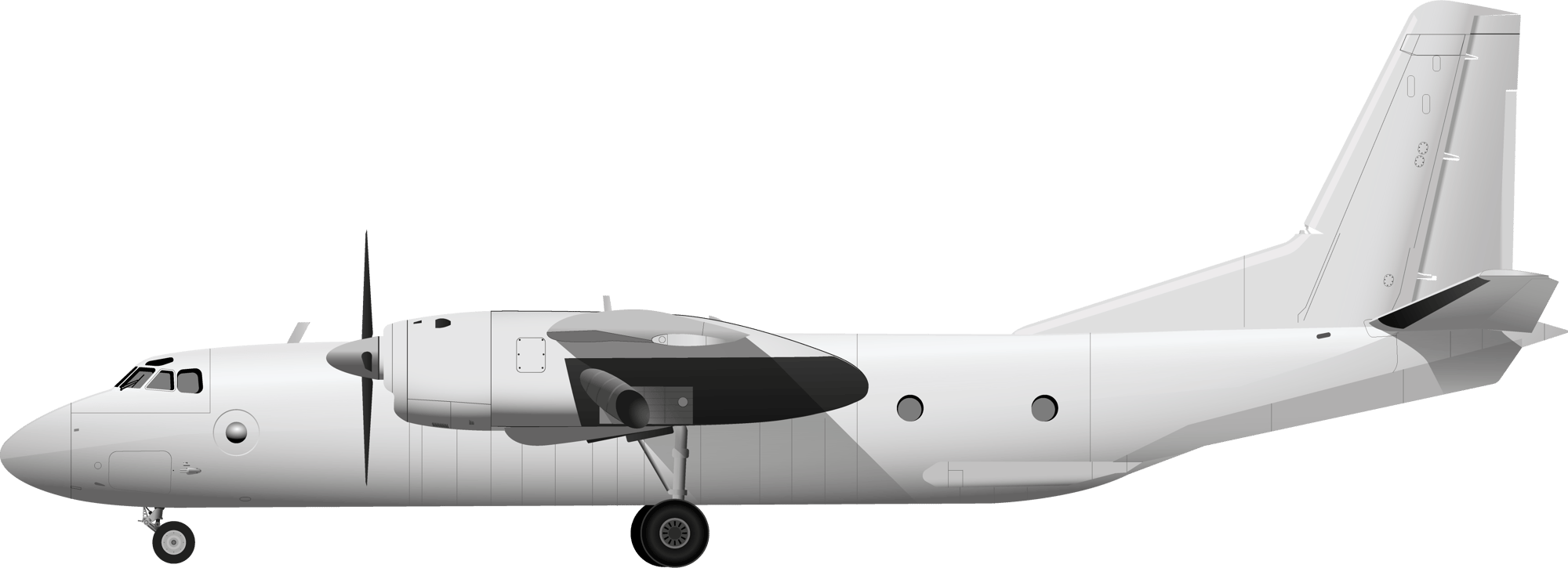
Top Down Cutaway
Main Deck
Cargo Cross Section
Main Deck
Width: 74 in
Height: 55 in
Max Payload
Cubic ft: 1,348
Weight: 12,100
Rear Cargo Door
Width: 86 in
Height: 64 in

Range & Routes
The An-26 is optimized for short-to-medium-haul cargo operations. Its capabilities shine in remote and rugged environments, where its short takeoff and landing performance is most beneficial. It has a range of 680 miles at maximum payload.
Airport Requirements
The An-26 is equally capable of operating at modern airports at sea level or unprepared airstrips and at high elevations in almost any weather. With its powerful turboprop engines and rugged design, the aircraft is comfortable working in adverse conditions.
Taxiway Width: The minimum recommended edge-to-edge width of a taxiway for the aircraft is 50 feet. It can operate on narrow taxiways of only 40 feet wide if necessary.
Parking Apron Space: If available, the recommended space around the aircraft needed for ground service equipment is 100 feet x 100 feet to accommodate its wingspan and clearance for loading and unloading at the rear of the aircraft.
Ground Handling: The aircraft can operate without extensive ground handling infrastructure. However, the most rudimentary equipment should be considered to assist those responsible for loading and unloading the aircraft. For speed and efficiency, forklifts are recommended.
Fueling: Refueling may be carried out using fuel trucks. The An-26’s fuel capacity is up to 2,430 gallons, depending on the payload and flight distance.
Runway Requirements
Takeoff Runway Length: At maximum payload, the An-24 typically requires 4,500 feet of runway for takeoff. With lighter payloads, the aircraft may be able to take off on even shorter runways. This requirement can vary based on altitude, temperature, and wind conditions. High-altitude airports with elevations over 8,000 feet may require slightly longer runways due to lower air density.
Landing Runway Length: At maximum payload, the aircraft typically requires a runway length of only 3,600 feet. Wet, icy, or unpaved runways may increase the minimum landing distance required for safe operation.
Crew
The An-26 is typically flown with two pilots, one radio operator, one flight engineer, and one navigator. Additional cargo support personnel may be assigned to the flight by the carrier to monitor the cargo and coordinate precise end-to-end delivery.
KEY AIRCRAFT SPECIFICATIONS
Length
78 feet
Wingspan
96 feet
Maximum Takeoff Weight
52,900 pounds
Maximum Payload
Approximately 12,100 pounds
Range
680 miles with a full payload
Cargo Volume
Approximately 1,348 cubic feet
Cruise Speed
270 miles per hour
Engines
Typically equipped with two Progress AI-24VT turboprop engines with four-blade propellers
Shorts SD 360
Intended for short-haul flights and able to operate from short runways, this aircraft has a good payload for its size. A square-section hold provides excellent volumetric utilization for larger loads.
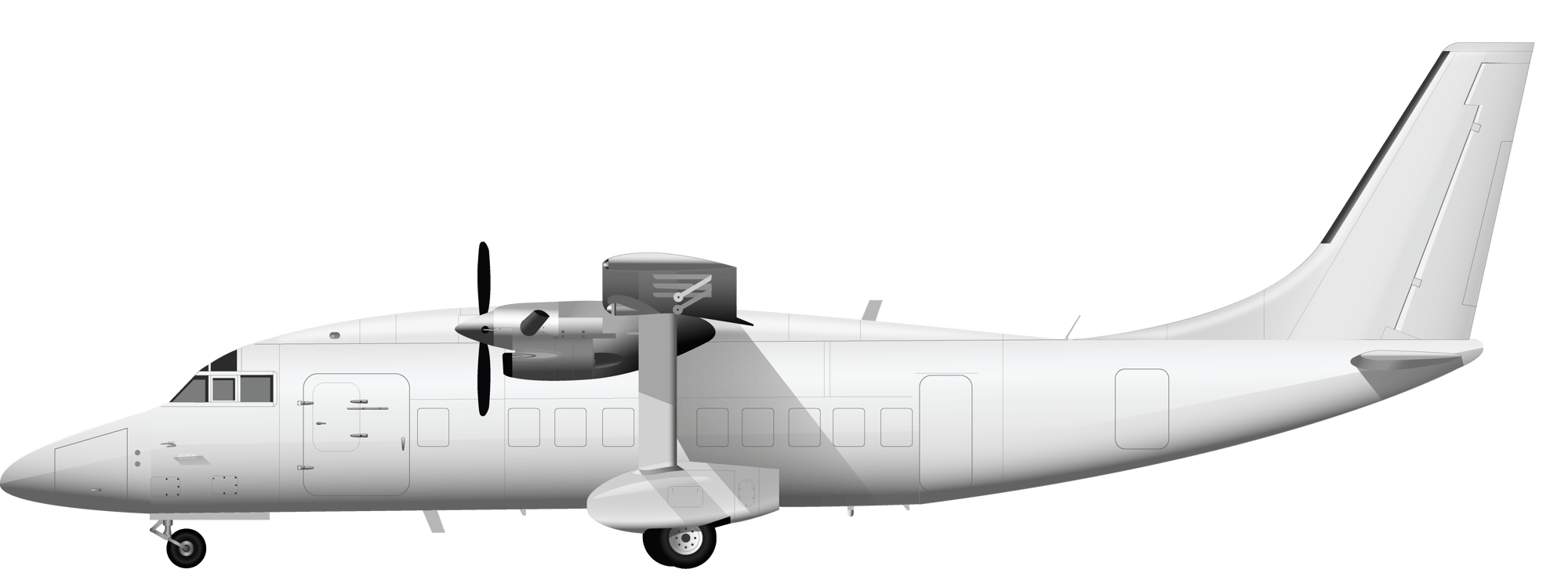
Top Down Cutaway
Main Deck
Side Cargo Doors
Width: 55 in
Height: 65 in
Max Payload
Cubic ft: 922
Weight: 3,200

Range & Routes
The SD 360 is optimized for short-haul, low-capacity routes, particularly on routes where operating larger jets would be too costly or airport runway length would make landing impossible.
Airport Requirements
The SD 360 is designed to operate out of regional airports and small airports with short runways and limited infrastructure. It can operate from regional airports with paved and unpaved runways, and rough airstrips.
Taxiway Width: The minimum recommended edge-to-edge width of a taxiway for the aircraft is 50 feet wide. It can operate on taxiways as narrow as 40 feet wide if necessary.
Parking Apron Space: If available, the recommended space around the aircraft needed for ground service equipment is 80 feet x 80 feet to accommodate its wingspan and clearance for loading and unloading.
Ground Handling: Forklifts are recommended for palletized cargo and crates, and belt loaders for small containers and loose packages. A tow tractor for pushback may be required if the aircraft is unable to proceed forward when departing the parking apron.
Fueling: Refueling may be carried out using fuel trucks. The SD 360’s fuel capacity is up to 575 gallons, depending on the payload and flight distance.
Runway Requirements
Takeoff Runway Length: At maximum payload, the SD 360 typically requires 3,800 feet of runway for takeoff. With lighter payloads, the aircraft may be able to take off on even shorter runways. This requirement may vary based on altitude, temperature, and wind conditions. High-altitude airports with elevations over 8,000 feet may require slightly longer runways due to lower air density.
Landing Runway Length: At maximum payload, the aircraft typically requires a runway length of only 2,800 feet. Wet, icy, or unpaved runways may increase the minimum landing distance required for safe operation.
Crew
The SD 360 is typically flown with two pilots. Additional cargo support personnel may be assigned to the flight by the carrier to monitor the cargo and coordinate precise end-to-end delivery.
KEY AIRCRAFT SPECIFICATIONS
Length
71 feet
Wingspan
75 feet
Maximum Takeoff Weight
12,300 pounds
Maximum Payload
Approximately 3,200 pounds
Range
990 miles with a full payload
Cargo Volume
Approximately 922 cubic feet
Cruise Speed
210 miles per hour
Engines
Typically equipped with two Pratt & Whitney Canada PT6A-65AR turboprop engines
Fairchild Metro II
A small, twin-engined aircraft for short haul delivery of urgent supplies. Loaded through a large cargo door, it can carry seven Euro-pallets with a total mass just over one ton.

Top Down Cutaway
Main Deck
Side Cargo Door
Width: 53 in
Height: 51 in
Max Payload
Cubic ft: 88
Weight: 2,755

Range & Routes
With its advantages in speed, range, and pressurized fuselage, the Metro II is best used for short-haul, high-speed regional operations where flying larger aircraft is less economical.
Airport Requirements
The Metro II is designed to operate out of regional airports with limited infrastructure, and small airports with paved, asphalt, or concrete runways. It can operate from gravel runways if properly modified for the task.
Taxiway Width: The minimum recommended edge-to-edge width of a taxiway for the aircraft is 50 feet wide.
Parking Apron Space: If available, the recommended space around the aircraft needed for ground service equipment is 60 feet x 60 feet to accommodate its wingspan and clearance for loading and unloading. It does not have a tight turning radius and requires more space to maneuver on smaller airfields.
Ground Handling: Belt loaders and carts are recommended for the speedy and efficient handling of light cargo, small containers, and loose packages. Forklifts are recommended for bulkier, heavier cargo. The aircraft does not have a steerable nosewheel, so a tow tractor for pushback may be required if the aircraft is unable to proceed forward with plenty of room when departing the parking apron.
Fueling: Refueling may be carried out using fuel trucks. The Metro II’s fuel capacity is up to 640 gallons, depending on the payload and flight distance.
Runway Requirements
Takeoff Runway Length: At maximum payload, the Metro II typically requires 4,500-5,000 feet of runway for takeoff. With lighter payloads, the aircraft may be able to take off on even shorter runways. This requirement may vary based on altitude, temperature, and wind conditions. High-altitude airports with elevations over 8,000 feet may require slightly longer runways due to lower air density.
Landing Runway Length: At maximum payload, the aircraft typically requires a runway length of only 3,500 feet. Wet, icy, or unpaved runways may increase the minimum landing distance required for safe operation.
Crew
The Metro II is typically flown with two pilots. Additional cargo support personnel may be assigned to the flight by the carrier to monitor the cargo and coordinate precise end-to-end delivery.
KEY AIRCRAFT SPECIFICATIONS
Length
59 feet
Wingspan
57 feet
Maximum Takeoff Weight
16,000 pounds
Maximum Payload
Approximately 2,755 pounds
Range
680 miles with a full payload
Cargo Volume
Approximately 400 cubic feet
Cruise Speed
320 miles per hour
Engines
Typically equipped with two Garrett AiResearch TPE-331 turboprop engines
Boeing 737-400F
The larger, longer-range version of the workhorse 737. Known for its efficiency and payload capacity, this aircraft is a popular choice for short- and medium-haul transport.
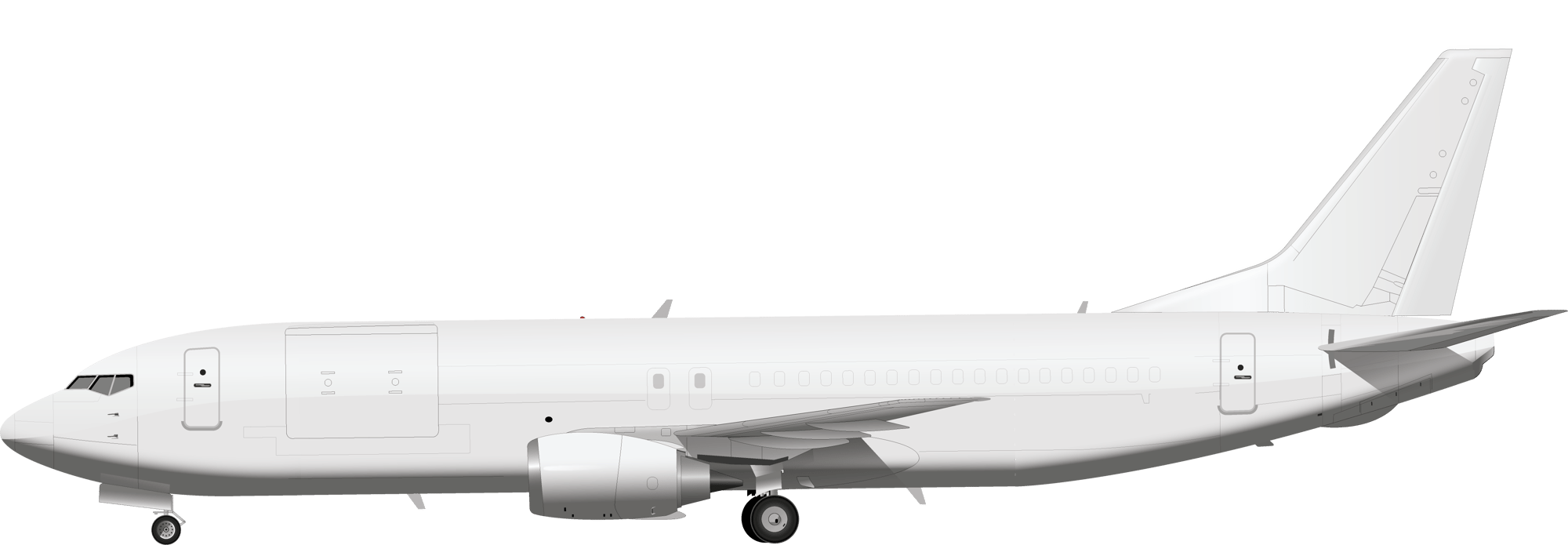
Top Down Cutaway
Main Deck (Top)
Lower Deck (Bottom)
Side Cargo Doors
Main Deck
Width: 139 in
Height: 81 in
Lower Deck Fore
Width: 44 in
Height: 33 in
Max Payload
Cubic ft: 4,600
Weight: 42,300

Range & Routes
The Boeing 737-400F has a non-stop range of approximately 2,300 miles at maximum payload, making it ideal for higher-capacity domestic routes and remote locations throughout the US, Canada, and Mexico.
Airport Requirements
The 737-400F is a narrow-body jet designed to takeoff and land from relatively short paved and concrete runways typically found at small and large commercial airports. If properly modified, the aircraft can service undeveloped areas where only gravel or unpaved runways are available.
Taxiway Width: The aircraft’s length of 120 feet and wingspan of 95 feet allows it to operate on standard commercial size taxiways with a minimum width of 75 feet.
Parking Apron Space: At the minimum, the 737-400F requires a parking apron of 150 feet x 150 feet to accommodate the external dimensions of the aircraft with additional room for ground and service equipment.
Ground Handling: The aircraft requires a scissor lift or cargo loader to lift cargo to the main deck. Belt or cargo loaders may be used to transfer cargo on the lower deck.
Fueling: Fueling may be carried out using large capacity fuel trucks or fueling systems capable of transferring large quantities of fuel. Fuel capacity is dependent on the weight of the payload carried by the aircraft and the range of travel required but can be up to 5,400 gallons.
Power and Air Support: The aircraft is equipped with an internal auxiliary power unit to provide electrical and pneumatic power when the engines are not running. The aircraft may also be connected to a ground power unit to power electrical and pneumatic systems.
Runway Requirements
Takeoff Runway Length: The minimum runway length for a 737-400F at maximum payload is approximately 8,500 feet. This requirement will vary based on altitude, temperature, wind conditions and runway conditions. High-altitude airports with elevations over 8,000 feet may require longer runways due to lower air density.
Landing Runway Length: The 737-400F at maximum payload requires a minimum runway length of 5,000 feet. Wet, icy, unpaved, gravel, or grass runways may increase the minimum landing distance required for safe operation.
Crew
The Boeing 737-400F is operated by two pilots. Additional cargo support personnel may be assigned to the flight by the carrier to monitor the cargo and coordinate seamless end-to-end delivery.
KEY AIRCRAFT SPECIFICATIONS
Length
120 feet
Wingspan
95 feet
Maximum Takeoff Weight
148,000 pounds
Maximum Payload
Approximately 45,000 pounds
Range
Approximately 2,300 miles with a full payload including crew, fuel, and cargo
Cargo Volume
Approximately 5,600 cubic feet
Cruise Speed
450 miles per hour
Engines
Typically equipped with two CFM International CFM56 turbofan engines
Antonov An-12
A medium-range air freighter with rear loading doors and ramp under a high tail. This configuration simplifies loading and unloading and enables operation from shorter runways than aircraft of similar capacity need.
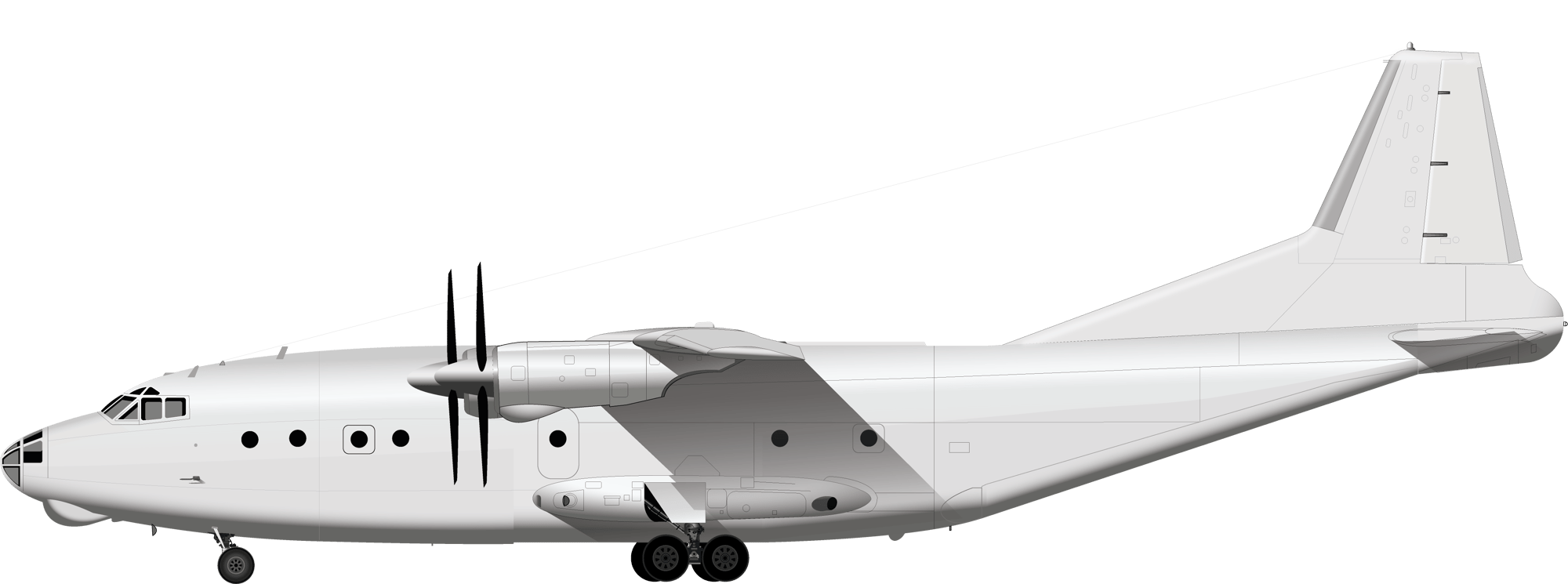
Top Down Cutaway
Main Deck
Cargo Cross Section
Main Deck
Width: 135 in
Height: 80 in
Max Payload
Cubic feet: 3,180
Weight: 44,000
Rear Cargo Door
Width: 117 in
Height: 116 in

Range & Routes
The An-12 has a non-stop range of approximately 2,200 miles at maximum payload, making it ideal for domestic routes and remote locations throughout the US, Canada, and Mexico.
Airport Requirements
The An-12 has very modest airport requirements and can operate on the shortest unpaved and undeveloped runways or paved and concrete runways typically found at small and large commercial airports.
Taxiway Width: The aircraft’s length of 109 feet and wingspan of 125 feet allows it to operate on standard commercial size taxiways with a minimum width of 75 feet.
Parking Apron Space: At minimum, the An-12 requires a parking apron of 164 feet x 135 feet to accommodate the external dimensions of the aircraft, with additional room for ground and service equipment working at the rear of the aircraft.
Ground Handling: The aircraft requires forklifts or cargo loaders to lift or roll on cargo using the ramp. Belt or cargo loaders may be used to load lighter cargo.
Fueling: Fueling may be carried out using large capacity fuel trucks or fueling systems capable of transferring large quantities of fuel. Fuel capacity is dependent on the weight of the payload carried by the aircraft and the range of travel required but can be up to 7,500 gallons.
Power and Air Support: The aircraft is not equipped with an internal auxiliary power unit and requires ground power units to power electrical and pneumatic systems when the engines are not running.
Runway Requirements
Takeoff Runway Length: The minimum runway length for the An-12 at maximum payload is approximately 8,850 feet. This requirement will vary based on altitude, temperature, wind conditions, and runway conditions. High-altitude airports at elevations over 8,000 feet may require longer runways due to lower air density.
Landing Runway Length: The An-12 at maximum payload requires a minimum runway length of 4,300 feet. Wet, icy, unpaved, gravel, or grass runways may increase the minimum landing distance required for safe operation.
Crew
The An-12 is operated by a crew of five: 2 pilots, a flight engineer, a navigator, and a radio operator. Additional cargo support personnel may be assigned to the flight by the carrier to monitor the cargo and coordinate seamless end-to-end delivery.
KEY AIRCRAFT SPECIFICATIONS
Length
109 feet
Wingspan
125 feet
Maximum Takeoff Weight
134,500 pounds
Maximum Payload
Approximately 44,000 pounds
Range
Approximately 2,200 miles with a full payload including crew, fuel, and cargo
Cargo Volume
Approximately 3,180 cubic feet
Cruise Speed
350 miles per hour
Engines
Typically equipped with 4 Ivchenko AI-20L or AI-20M turboprop engines
McDonnell Douglas DC-9 15F
A smaller, twin-engined jet built for short-to-medium-range transportation. Cargo capacity is a little over 10 tons, but the ability to use shorter runways increases the versatility of this aircraft.

Top Down Cutaway
Main Deck (Top)
Lower Deck (Bottom)
Max Payload
Cubic Feet: 4,562
Weight: 22,930
Side Cargo Door
Main Deck
Width: 136 in
Height: 81 in
Lower Deck
Fore and Aft
Width: 106 in
Height: 67 in

Range & Routes
The DC-9 has a non-stop range of approximately 1,650 miles at maximum payload, making it ideal for domestic routes and remote locations throughout the US, Canada, and Mexico.
Airport Requirements
The DC-9 has very modest airport requirements and can operate from relatively short paved and concrete runways typically found at small and large commercial airports.
Taxiway Width: The aircraft’s length of 109 feet and wingspan of 125 feet allows it to operate on standard commercial size taxiways with a minimum width of 75 feet.
Parking Apron Space: At minimum, the DC-9 requires a parking apron of 135 feet x 135 feet to accommodate the external dimensions of the aircraft and for easy access of service vehicles.
Ground Handling: The aircraft is designed with a low profile, allowing for efficient loading and unloading using forklifts, belt loaders, and cargo loaders.
Fueling: Fueling may be carried out using large capacity fuel trucks or fueling systems capable of transferring large quantities of fuel. Fuel capacity is dependent on the weight of the payload carried by the aircraft and the range of travel required but can be up to 4,900 gallons.
Power and Air Support: The aircraft is equipped with an internal auxiliary power unit located in the aft fuselage and may also be connected to ground power units to power electrical and pneumatic systems when the engines are not running.
Runway Requirements
Takeoff Runway Length: The minimum runway length for the DC-9 at maximum payload is approximately 6,000 feet. This requirement will vary based on altitude, temperature, wind conditions, and runway conditions. High-altitude airports at elevations over 8,000 feet may require longer runways due to lower air density.
Landing Runway Length: The DC-9 at maximum payload requires a minimum runway length of 5,000 feet. Wet, icy, unpaved, gravel, or grass runways may extend the minimum landing distance required for safe operation.
Crew
The DC-9 is operated by two pilots. Additional cargo support personnel may be assigned to the flight by the carrier to monitor the cargo and coordinate seamless end-to-end delivery.
KEY AIRCRAFT SPECIFICATIONS
Length
104 feet
Wingspan
90 feet
Maximum Takeoff Weight
90,000 pounds
Maximum Payload
Approximately 22,930 pounds
Range
Approximately 1,650 miles with a full payload including crew, fuel, and cargo
Cargo Volume
Approximately 4,562 cubic feet
Cruise Speed
550 miles per hour
Engines
Typically equipped with two Pratt & Whitney JT8D turbofan engines
Fairchild Metro III
An upgrade to the Metro II, thanks to a reinforced floor this has significantly higher payload, though smaller cargo volume. Like its predecessor, it’s intended for short-range, time-sensitive deliveries.

Top Down Cutaway
Main Deck
Side Cargo Door
Width: 53 in
Height: 51 in
Max Payload
Cubic feet: 385
Weight: 4,410

Range & Routes
With its advantages in speed, range, and pressurized fuselage, the Metro III is best used for short-haul, high-speed regional operations where flying larger aircraft is less economical.
Airport Requirements
The Metro III is designed to operate out of regional airports with limited infrastructure, and small airports with paved, asphalt, or concrete runways. It can operate from gravel runways if properly modified for the task.
Taxiway Width: The minimum recommended edge-to-edge width of a taxiway for the aircraft is 50 feet wide.
Parking Apron Space: If available, the recommended space around the aircraft needed for ground service equipment is 60 feet x 60 feet to accommodate its wingspan and clearance for loading and unloading. It does not have a tight turning radius and requires more space to maneuver on smaller airfields.
Ground Handling: Belt loaders and carts are recommended for the speedy and efficient handling of light cargo, small containers, and loose packages. Forklifts are recommended for bulkier, heavier cargo. The aircraft does not have a steerable nosewheel, so a tow tractor for pushback may be required if the aircraft is unable to proceed forward when departing the parking apron.
Fueling: Refueling may be carried out using fuel trucks. The Metro III’s fuel capacity is up to 640 gallons, depending on the payload and flight distance.
Power and Air Support: The Metro III does not have an internal auxiliary power unit and requires a ground power unit to power internal avionics and electrical systems when the engines are off.
Runway Requirements
Takeoff Runway Length: At maximum payload, the Metro III typically requires 4,500-5,000 feet of runway for takeoff. With lighter payloads, the aircraft may be able to take off on even shorter runways. This requirement may vary based on altitude, temperature, and wind conditions. High-altitude airports with elevations over 8,000 feet may require slightly longer runways due to lower air density.
Landing Runway Length: At maximum payload, the aircraft typically requires a runway length of only 3,500 feet. Wet, icy, or unpaved runways may increase the minimum landing distance required for safe operation.
Crew
The Metro III is typically flown with two pilots. Additional cargo support personnel may be assigned to the flight by the carrier to monitor the cargo and coordinate precise end-to-end delivery.
KEY AIRCRAFT SPECIFICATIONS
Length
59 feet
Wingspan
57 feet
Maximum Takeoff Weight
16,000 pounds
Maximum Payload
Approximately 4,100 pounds
Range
680 miles with a full payload
Cargo Volume
Approximately 420 cubic feet
Cruise Speed
320 miles per hour
Engines
Typically equipped with two Garrett AiResearch TPE-331 turboprop engines
Embraer EMB-110 Bandeirante
“Bandit” in English, this small, twin-engined Brazilian aircraft is known for its proven reliability. It’s a good choice for transporting smaller loads over short-to-medium distances.
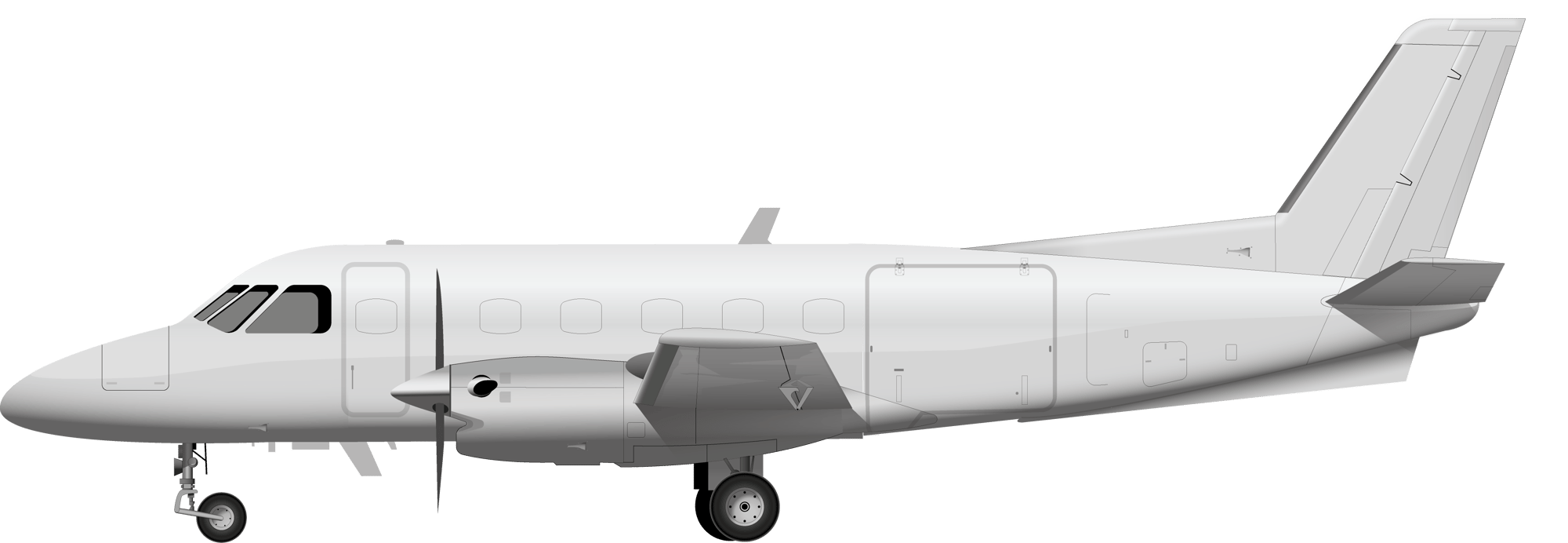
Top Down Cutaway
Main Deck
Side Cargo Door
Width: 75 in
Height: 55 in
Max Payload
Cubic Feet: 490
Weight: 3,500

Range & Routes
With its advantages in short takeoff and landing, powerful fuel-efficient engines, and ability to operate in underdeveloped areas, the EMB-110 is best used for short-haul operations where flying larger aircraft is less economical or cannot operate due to lack of necessary infrastructure.
Airport Requirements
While the EMB-110 enjoys flying from well-equipped and serviced regional airports with asphalt or concrete runways, it is at home in rugged, underdeveloped areas with limited infrastructure where it is capable of operating from compacted gravel or dirt strips with limited length and in rough conditions.
Taxiway Width: The minimum recommended edge-to-edge width of a taxiway for the aircraft is 50 feet wide.
Parking Apron Space: If available, the recommended space around the aircraft needed for ground service equipment is 80 feet x 80 feet to accommodate its wingspan and clearance for service vehicles during loading and unloading.
Ground Handling: Belt loaders and carts are recommended for the speedy and efficient handling of light cargo, small containers, and loose packages. Forklifts are recommended for bulkier, heavier cargo. The aircraft has a steerable nosewheel, so a tow tractor for pushback or tow is optional.
Fueling: Refueling may be carried out using fuel trucks. The EMB-110’s fuel capacity is up to 450 gallons, depending on the payload and flight distance.
Power and Air Support: The EMB-110 does not normally have an internal auxiliary power unit and requires a ground power unit to power internal systems when the engines are off. Battery starts for the engines can be used in cases where a ground power unit is not available.
Runway Requirements
Takeoff Runway Length: At maximum payload, the EMB-110 typically requires only 3,000 feet of runway for takeoff. With lighter payloads, the aircraft can take off on even shorter runways. This requirement may vary based on altitude, temperature, and wind conditions. High-altitude airports with elevations over 8,000 feet may require slightly longer runways due to lower air density.
Landing Runway Length: At maximum payload, the aircraft typically requires a runway length of only 2,200 feet. Wet, icy, or unpaved runways may increase the minimum landing distance required for safe operation.
Crew
The EMB-110 is flown with two pilots. Additional cargo support personnel may be assigned to the flight by the carrier to monitor the cargo and coordinate precise end-to-end delivery.
KEY AIRCRAFT SPECIFICATIONS
Length
50 feet
Wingspan
50 feet
Maximum Takeoff Weight
13,000 pounds
Maximum Payload
Approximately 3,500 pounds
Range
1,200 miles with a full payload
Cargo Volume
Approximately 490 cubic feet
Cruise Speed
255 miles per hour
Engines
Typically equipped with two Pratt & Whitney Canada PT6A-34 turboprop engines
Piper PA-31
This cargo version of the successful Piper Navajo is ideal for urgent deliveries of supplies into small airports and airfields. Twin-engined, it is known for high reliability and good performance.
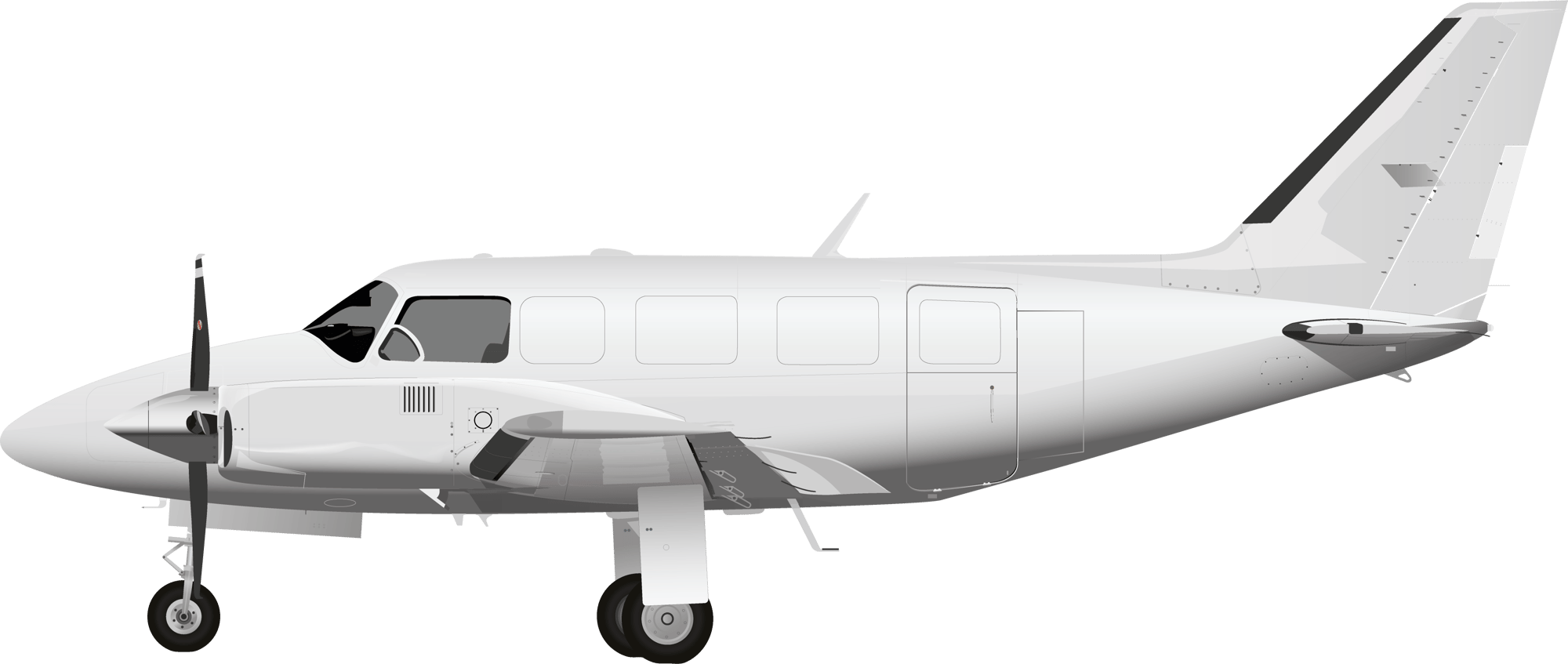
Top Down Cutaway
Main Deck
Side Cargo Door
Width: 40 in
Height: 40 in
Side Cargo Door
Door 1
Width: 26 in
Height: 40 in
Door 2
Width: 14 in
Height: 17.7 in
Max Payload
Cubic feet: 1,348
Weight: 1,200

Range & Routes
With its advantages in low-speed handling, moderate runway requirements, and ability to operate on rural or gravel strips, the PA-31 is best used for regional hauls or point-to-point hops between isolated communities.
Airport Requirements
While the PA-31 operates well from regional airports with asphalt or concrete runways, it is equally capable in rugged, underdeveloped areas with limited infrastructure. It can take off and land on compacted gravel or dirt strips with limited length and in rough conditions.
Taxiway Width: The minimum recommended edge-to-edge width of a taxiway for the aircraft is 80 feet at standard airports. However, in rural or remote locations, the aircraft can operate on taxiways as narrow as 40 to 50 feet due to its excellent handling.
Parking Apron Space: If available, the recommended space around the aircraft needed for ground service equipment is 70 feet x 70 feet to accommodate its wingspan and clearance for service vehicles for loading, unloading, and fueling.
Ground Handling: Manual handling of light cargo, small containers, and loose packages is recommended. The aircraft has a steerable nosewheel, so a tow tractor for pushback or tow is optional.
Fueling: Refueling may be carried out using fuel trucks. The aircraft’s fuel capacity is up to 190 gallons, depending on the payload and flight distance.
Power and Air Support: The PA-31 doesn’t necessarily require a ground power unit in normal operations but one could be useful in cold weather, during frequent stops to preserve battery life, or maintenance checks of powered systems.
Runway Requirements
Takeoff Runway Length: At maximum payload, the PA-31 typically requires only 1,500 feet of runway for takeoff. With lighter payloads, the aircraft can take off on even shorter runways. This requirement may vary based on altitude, temperature, and wind conditions. High-altitude airports with elevations over 8,000 feet may require slightly longer runways due to lower air density.
Landing Runway Length: At maximum payload, the aircraft typically requires a runway length of only 1,300 feet, but shorter runways are possible with lighter cargo or when empty. Wet, icy, or unpaved runways may increase the minimum landing distance required for safe operation.
Crew
The PA-31 can be flown with one pilot. Additional cargo support personnel may be assigned to the flight by the carrier to monitor the cargo and coordinate precise end-to-end delivery.
KEY AIRCRAFT SPECIFICATIONS
Length
33 feet
Wingspan
41 feet
Maximum Takeoff Weight
6,500 pounds
Maximum Payload
Approximately 1,200 pounds
Range
1,165 miles with a full payload
Cargo Volume
Approximately 140 cubic feet
Cruise Speed
240 miles per hour
Engines
Typically equipped with two Lycoming TIO-540-A turbocharged piston engines
Air Charter Freight
Whether facing ultracritical deliverydeadlines or arranging transport from aremote location, it’s vital to use the rightaircraft. Here’s what makes us special—and key information about our fleet.
Blog and Resource Center
How AirFreight.com Solved a PGA Tour Shipping Emergency
Learn how AirFreight.com located a lost shipment and helped save the PGA Golf Tour.
How AirFreight.com Saved The Farm By Solving A Major Shipping Delay
Learn how we saved a Montana-based artisanal farm thousands of dollars by expediting a shipment of perishable goods.
Expedited Shipping Vendor Comparison
We’ve done the research for you. This vendor comparison sheet breaks down how AirFreight.com stacks up against the competition.






